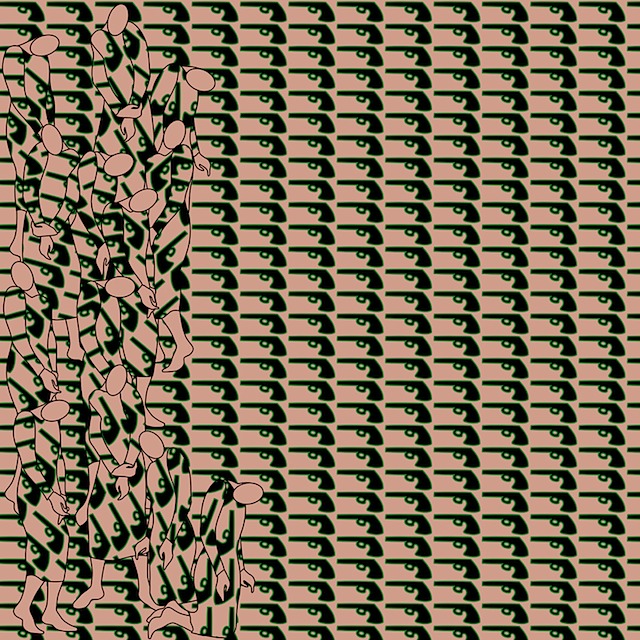
A subversive study in “Ornament and Crime” at Macalester College’s Law Warschaw Gallery
Parastou Forouhar, balloon installation (detail), “Thousandandone Day,” ongoing since 2003. Photo courtesy of the artist’s website
The high ceilings at the entry of Parastou Forouhar’s new exhibition at Macalester College, “Ornament and Crime,” are festooned with Mylar balloons, as if for a party. Seen from the floor below, the balloons’ surfaces look festive and simply decorative – repeated arrangements of curvaceous, pale pink shapes, looped together with thickly drawn black lines. Pull a balloon down to examine it more closely, though, and the black-and-pink patterning resolves into deeply unsettling, stylized images of variously bound and blindfolded figures, sometimes kneeling, sometimes prostrated before their captors.
It’s a fitting entrance to the show – seduction turned sour, trauma made decorative and all the more terrible for the aesthetic appeal and restraint of its pretty design. Forouhar is an Iranian exile, living in Germany since 1991, when her parents were assassinated by the ruling regime. And her work seethes with the anguish and anger of that history, but in a way rendered so subtly and with such panache that the knife-edge of horror slices deep into your imagination before you even register the cut.
Parastou Forouhar, “Red is My Name, Green is My Name I,” digital drawing (“Green #6”), 2008. Courtesy of the artist
On the wall facing the balloons is a charming array of butterflies in a variety of complementary designs, like feminine, high-end wallpaper. The look of it is appealing and vaguely Asiatic from a distance – but after the balloons, I’m wary as I draw near to look at them. And I’m right to be: the butterflies are made from Escher-like tableaux of violation and abuse – intertwined, overlapping and repeated images of broken and bloodied human figures, many of them naked and female: they are by turns cut, shot, stretched painfully or hunched in defeat, imprisoned, collapsed, perhaps dead, and stacked atop one another.
Parastou Forouhar, “Friday,” (detail), photograph, 2003. Courtesy of Macalester College Law Warschaw Gallery
Around the corner are several prints, “Red is My Name, Green is My Name:” intricate grids of repeating, fluid arrangements of calligraphic forms rendered in striking, saturated color – rich crimson, black, emerald, and soft ecru. The lavish nature of the design is at stark odds with the objects embedded in the patterning, all instruments of violence and torture: erect male genitalia, razors and pliers, whips, pistols and knives. Embedded in fluid lines of grid are more images of subjugation and bondage. And across the gallery, on the opposite wall, are still more: black and beige eye-fooling pieces, shifting like Rorschach blots between scenes of violent degradation and elegant decorative patterning. Off to the side is a table with a series of four smartly designed, small pink-and-black flip-books, echoes of the balloons up front; pick up a book, flip its pages and you inadvertently take a hand in still more scenes of captivity and pain.
Installation view (detail), “In the Time of Butterflies,” wallpaper, 2011. Photo by Susannah Schouweiler
Bookending the show are bracing images of defiance, a welcome reprieve from the pretty monstrosities adorning the rest of the gallery: a photograph on one wall, “Flashing,” shows a woman facing a window display featuring an ad with a young male model. She’s shown from behind, covered head to toe in a thick black chador, but with her arms holding the fabric and spread wide, revealing herself to the man’s image. To the viewer, she’s a dark silhouette of the butterflies on the opposite side of the wall. On the back wall of the gallery are four large panels, together comprising a large photograph, “Friday” – so named for the last day of the Islamic work week and a religiously significant day of public prayer and reflection. The panels are covered with a large print depicting inky black, thick, floral embroidered fabric – a chador. The only break in the drape of the fabric, the only visible flesh is a thumb and forefinger at the center of the image; a woman is clutching a fistful of her chador – perhaps, like the woman across the way, preparing to rip it aside?
“Red is My Name, Green is My Name” (Red #3), digital drawing, 2008. Courtesy of the artist’s website
“Ornament and Crime” is a dissonant, aesthetically sophisticated, politically caustic body of work – a cerebral, understated exhibition sure to nettle your sensibilities and leave you feeling rattled for some time after you’ve seen it. It’s also one of the most substantive, intriguing bodies of work I’ve seen in a long while, and well worth a visit to the gallery.
Installation view at Law Warschaw Gallery, “Thousandandone Day” balloons. Photo by Susannah Schouweiler
“Ornament and Crime: Parastou Forouhar” is on view through March 10 in the Law Warschaw Gallery in the Janet Wallace Fine Arts Center at Macalester College, 1600 Grand Ave., St. Paul. For more information: www.macalester.edu/gallery.
Recent Content
-
Artsarticle ·
-
Artsarticle ·
-
Artsarticle ·





